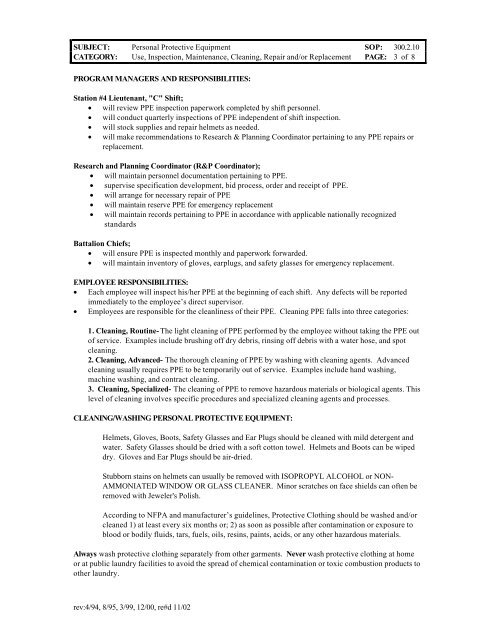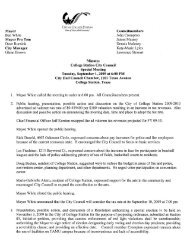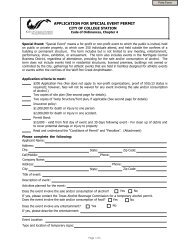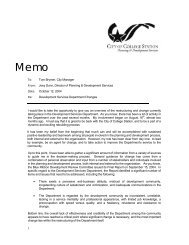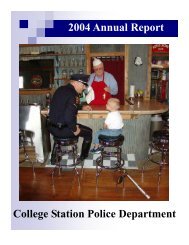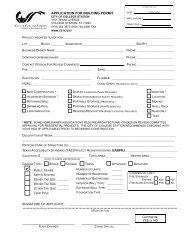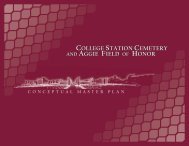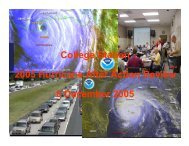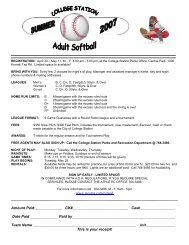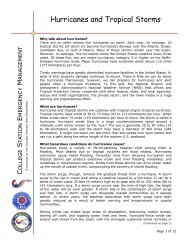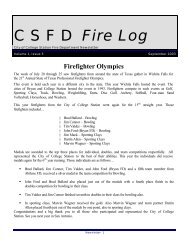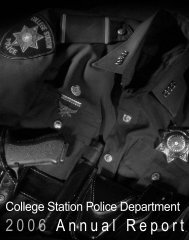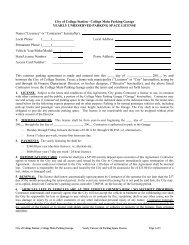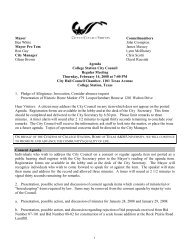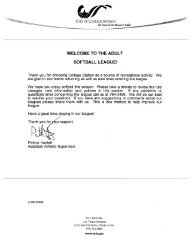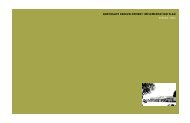standard operating procedure college station fire department
standard operating procedure college station fire department
standard operating procedure college station fire department
Create successful ePaper yourself
Turn your PDF publications into a flip-book with our unique Google optimized e-Paper software.
SUBJECT: Personal Protective Equipment SOP: 300.2.10<br />
CATEGORY: Use, Inspection, Maintenance, Cleaning, Repair and/or Replacement PAGE: 3 of 8<br />
PROGRAM MANAGERS AND RESPONSIBILITIES:<br />
Station #4 Lieutenant, "C" Shift;<br />
• will review PPE inspection paperwork completed by shift personnel.<br />
• will conduct quarterly inspections of PPE independent of shift inspection.<br />
• will stock supplies and repair helmets as needed.<br />
• will make recommendations to Research & Planning Coordinator pertaining to any PPE repairs or<br />
replacement.<br />
Research and Planning Coordinator (R&P Coordinator);<br />
• will maintain personnel documentation pertaining to PPE.<br />
• supervise specification development, bid process, order and receipt of PPE.<br />
• will arrange for necessary repair of PPE<br />
• will maintain reserve PPE for emergency replacement<br />
• will maintain records pertaining to PPE in accordance with applicable nationally recognized<br />
<strong>standard</strong>s<br />
Battalion Chiefs;<br />
• will ensure PPE is inspected monthly and paperwork forwarded.<br />
• will maintain inventory of gloves, earplugs, and safety glasses for emergency replacement.<br />
EMPLOYEE RESPONSIBILITIES:<br />
• Each employee will inspect his/her PPE at the beginning of each shift. Any defects will be reported<br />
immediately to the employee’s direct supervisor.<br />
• Employees are responsible for the cleanliness of their PPE. Cleaning PPE falls into three categories:<br />
1. Cleaning, Routine- The light cleaning of PPE performed by the employee without taking the PPE out<br />
of service. Examples include brushing off dry debris, rinsing off debris with a water hose, and spot<br />
cleaning.<br />
2. Cleaning, Advanced- The thorough cleaning of PPE by washing with cleaning agents. Advanced<br />
cleaning usually requires PPE to be temporarily out of service. Examples include hand washing,<br />
machine washing, and contract cleaning.<br />
3. Cleaning, Specialized- The cleaning of PPE to remove hazardous materials or biological agents. This<br />
level of cleaning involves specific <strong>procedure</strong>s and specialized cleaning agents and processes.<br />
CLEANING/WASHING PERSONAL PROTECTIVE EQUIPMENT:<br />
Helmets, Gloves, Boots, Safety Glasses and Ear Plugs should be cleaned with mild detergent and<br />
water. Safety Glasses should be dried with a soft cotton towel. Helmets and Boots can be wiped<br />
dry. Gloves and Ear Plugs should be air-dried.<br />
Stubborn stains on helmets can usually be removed with ISOPROPYL ALCOHOL or NON-<br />
AMMONIATED WINDOW OR GLASS CLEANER. Minor scratches on face shields can often be<br />
removed with Jeweler's Polish.<br />
According to NFPA and manufacturer’s guidelines, Protective Clothing should be washed and/or<br />
cleaned 1) at least every six months or; 2) as soon as possible after contamination or exposure to<br />
blood or bodily fluids, tars, fuels, oils, resins, paints, acids, or any other hazardous materials.<br />
Always wash protective clothing separately from other garments. Never wash protective clothing at home<br />
or at public laundry facilities to avoid the spread of chemical contamination or toxic combustion products to<br />
other laundry.<br />
rev:4/94, 8/95, 3/99, 12/00, re#d 11/02


